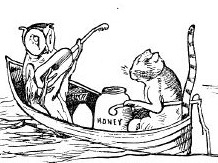Books like The Owl and the Pussycat
The Owl and the Pussycat
The Owl and the Pussycat and other nonsense is a book of Edward Lear's eccentric and unique comic verse, published in 2012 to celebrate the bicentenary of the author's birth. It is lavishly illustrated with watercolour paintings by the Australian artist, Robert Ingpen. This is a happy combination, as Ingpen's depictions, based on Australian flora, seem to be a perfect fit for Lear's imagined Bong-tree Land. Edward Lear was one of 20 children. He suffered from epilepsy, and had a very unhappy childhood as an unwanted member of the family. He was largely brought up by an elder sister who encouraged him to develop his artistic talent. Interestingly, Sarah, another sister of his, was also a talented artist and writer, though she is largely forgotten now. This edition of the book is dedicated to her memory. It includes seven of Edward Lear's most popular poems:The Owl and the PussycatThe JumbliesThe Dong with a Luminous NoseThe New VestmentsThe Duck and the KangarooCalico Pie and How Pleasant to Know Mr. LearIt is perfectly possible to read Lear's verse in a standard collection of poetry, as words on the page without the aid of pictures. Perhaps this is how most of us remember reading him in childhood. Or perhaps you may remember them being read aloud, as hearing them aloud benefits the language enormously. I would defy anyone not to "hear" them in their head as they read. But there is another consideration with this particular book.For those adults - and some children - who find Lear's eccentric descriptions all but impossible to visualise, these illustrations are not only very attractive but also a great help with interpretation. Lear's sing-song language is easy and repetitive, the sound of his verse and his imagery will delight young children, yet his ideas are sometimes so ludicrous as to be unimaginable. Can you see a "runcible spoon" in your mind's eye? Or "The Dong with a Luminous Nose"? I couldn't - even though in this case Lear gives a detailed description of him - until I looked at the illustrations."Far and few, far and fewAre the lands where the Jumblies live;Their heads are green and their hands are blue,And they went to sea in a Sieve."We first hear this refrain in "The Jumblies", and it is then echoed in "The Dong with a Luminous Nose", a poignant and mournful verse. Sad though it is, it is probably my personal favourite. Perhaps though, it is as well that it is followed by "The New Vestments"; such a silly piece of nonsense that it makes the reader laugh out loud. And small children will love the "rude" and funny picture in this book. "How Pleasant to Know Mr. LearWho has written such volumes of stuff!Some think him ill-tempered and queer,But a few think him pleasant enough."So where on earth did he get his odd ideas? What made him juxtapose such ridiculous items to make a more-or-less coherent whole? The answer seem to be that, in common with many comedians throughout history, he was trying to escape his own unhappiness. He started out as a draughtsman for the Zoological Society of London, making drawings of rare birds and animals. Some of his beautiful bird paintings from this time are included in the books. He entertained his employer's children with his drawings and invented nonsense rhymes, to which they showed, "uproarious delight and welcome at the appearance of every new absurdity." Imagine how welcome such approval must have been to a young man who had sadly experienced little of this in his life to date. He went on to travel throughout Europe, writing and illustrating guides to various places, and these came to the attention of Queen Victoria. She was so impressed that she promptly employed Edward Lear as her drawing master. In 1870 he published his most famous poem, The Owl and the Pussycat, with which he found his perfect niche. To the end of his days he commented on the world around him in a nonsensical style, referring most revealingly once to, "This ludicrously whirlygig life which one suffers from first and laughs at afterwards."Even writing what amounts to his own obituary, with a letter sent to a friend shortly before his travels, he ends it, typically,"Oh bother!" The text of the letter is included in the book, as is a short biography of the author. Additionally there are contributions by the illustrator, Robert Ingpen. He has written a two-page botanical study entitled "Bong-tree land", styled very much in the tradition of the time, plus another two pages about Bong-tree Land itself, reading rather like a nonsensical travel guide, starting,"Visitors to Bong-tree land must be prepared to travel by sea for a year and a day from almost any port in England."Robert Ingpen has captured the essence and style of Edward Lear very nicely, and this provides an unexpected extra tribute to the author. Edward Lear has influenced a host of writers and comedians ever since, including Gilbert and Sullivan, A. A. Milne, Spike Milligan, The Goons, Dr. Seuss and Monty Python's Flying Circus. If you have a penchant for the ridiculous, don't make the mistake of thinking him outdated, and pass Edward Lear by - give him a try. Perhaps he wrote his own epitaph with the words,"Nonsense is the breath of my nostrils."
